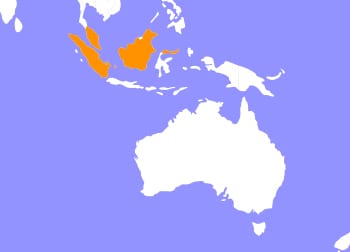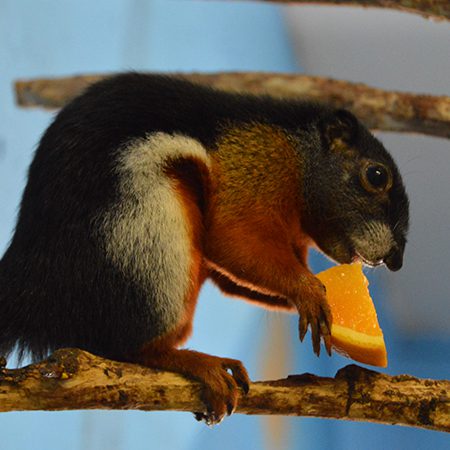Provost Squirrel
Callosciurus
These squirrels are a very colorful species of rodent found in the Thai-Malay Peninsula, Sumatra, and Bonero. They live in lowland and montane forests, the can be found in gardens and plantations as well. Another common name for th prevost squirrel is the asian tri-colored squirrel. The top of the head, back, and tail are jet-black or brownish, the underparts are reddish-brown, and a white line separates the two colors. Their tails are usually flat and has short hair. The average size of an adult squirrel is a little less than 1 foot, with a tail of 3 to 10 inches, weighing under 1 lb.
Prevost squirrels are arboreal mammals, they have become well adapted to life in the trees, they excel at climbing and jumping. They have toes with sharp claws that help them cling to tree trunks. When climbing and running around the tail can help these animals keep their balance, it can also act as a rudder when they jump. When on the ground, they move with graceful leaps, often pausing and poking their heads up to look around. When foraging they’ll look for fruit, nuts, seeds, nuds, flowers, insects, and bird eggs to eat. They will typically live a solitary life or in a small family group. This species is crepuscular, meaning they are mainly active at dusk and dawn. They have been observed wrapping their tails around themselves for warmth when they are sleeping.

Prevost Squirrels are found in the forests of the Southern Thai-Malay Peninsula.
HABITAT -They live in lowland and montane forests in southern parts of Asia.
DIET -They are omnivorous, eating fruits, nuts, seeds, buds, flowers, insects, and bird eggs.
FUN FACT -These squirrels are 3 different colors, sometimes also called the tri-colored squirrel.
SOCIAL BEHAVIOR -They can live solitary lives, or live in a small family group.
ACTIVITY -They are crepuscular, being most active at dawn and dusk.
PREDATORS -Predators of the prevost squirrel include eagles, martens, and humans.
SIZE -The average size of an adult squirrel is little less than 1 foot, with a tail of 3 to 10 inches, weighing under 1 lb.
RELATIVES -They are distant relatives of the tree squirrel, ground squirrels, chipmunks, marmots, and prairie dogs.
CONSERVATION -Prevost squirrels are categorized as LC (Least Concern) species by the IUCN.
Cub Creek Animal Care Information
Housing - Our prevost squirrels are housed in a specialized indoor enclosures in the habitats building and in the small animal room. Their enclosures are large giving them plenty of room to explore. You’ll find tree branches, ramps, and a large window to allow for natural light. Having tree branches and wooden limbs throughout the enclosure makes for a more simulated environment. Within the tree limbs we’ve built hide spaces for them, making things nice and cozy for them. The enclosure is bedded with shavings, and they always have access to clean water.
Diet - We feed our prevost squirrels a balanced diet that starts with primarily fruit! They love to eat apples, bananas, oranges, and other sweet treats. We also supplement this with a variety of vegetables and greens, sweet potato, squirrel mix, and small animal pellets.
Enrichment - We provide our prevost squirrels with plenty of enrichment to keep them stimulated and healthy. They are accustomed to human interaction, leaping onto shoulders being quite docile in nature. This stems from continual enrichment with toys and social interaction. During the summer, campers will make all kinds of toys for them, made out of cardboard and other materials!


